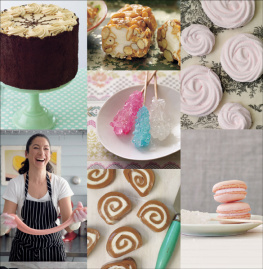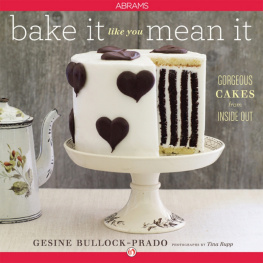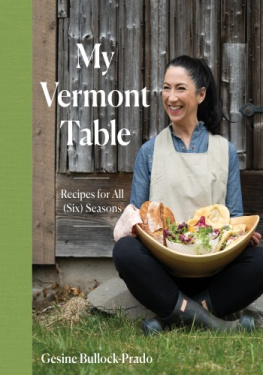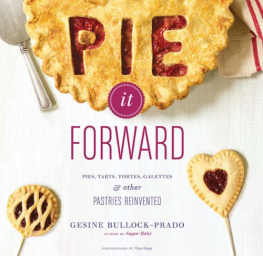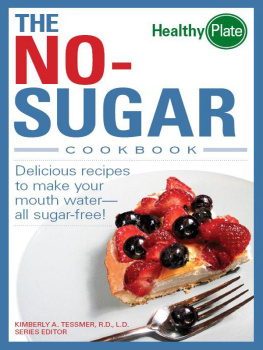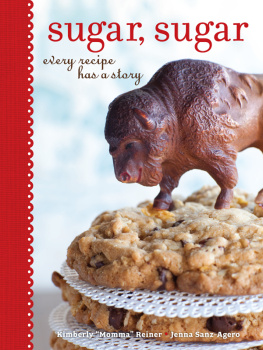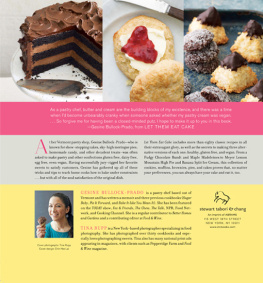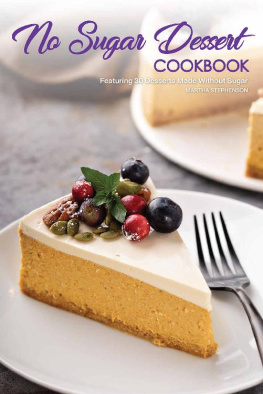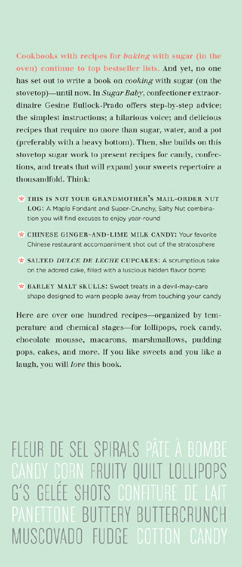



Published in 2011 by Stewart, Tabori & Chang
An imprint of ABRAMS
Copyright 2011 Gesine Bullock-Prado
Photographs copyright 2011 Tina Rupp
Props featured in this book were either the authors own or provided courtesy of Simon Pearce.
All rights reserved. No portion of this book may be reproduced, stored in a retrieval system, or transmitted in any form or by any means, mechanical, electronic, photocopying, recording, or otherwise, without written permission from the publisher.
Library of Congress Cataloging-in-Publication Data:
Bullock-Prado, Gesine.
Sugar baby / by Gesine Bullock-Prado.
p. cm.
ISBN 978-1-58479-897-2 (alk. paper)
1. Cooking (Sugar) 2. Cookbooks. I. Title.
TX819.S94B85 2010
641.6'36--dc22
2010037768
ISBN: 978-1-4532-7686-0
Editor: Natalie Kaire
Designer: Alissa Faden
Production Manager: Tina Cameron
The text of this book was primarily composed in Walbaum, Gotham, and Archer.
Stewart, Tabori & Chang books are available at special discounts when purchased in quantity for premiums and promotions as well as fundraising or educational use. Special editions can also be created to specification. For details, contact specialsales@abramsbooks.com or the address below.

www.abramsbooks.com

SUGARTHE PREQUEL!
A BRIEF HISTORY OF THE WORLD (AS IT PERTAINS TO SUGAR)
SECTION I
SIMPLE DISSOLVE TO THREAD STAGE
230F235F
(110C113C)
Sugar Concentration:
80%
SECTION II
SOFT-BALL STAGE
235F240F
(113C116C)
Sugar Concentration:
85%
SECTION III
FIRM-BALL STAGE
245F250F
(118C121C)
Sugar Concentration:
87%
SECTION IV
HARD-BALL STAGE
250F265F
(121C129C)
Sugar Concentration:
92%
SECTION V
SOFT-CRACK STAGE
270F290F
(132C143C)
Sugar Concentration:
95%
SECTION VI
HARD-CRACK STAGE (AND BEYOND)
300F310F
(149C154C)
Sugar Concentration:
99%
SECTION VII
PUT IT ALL TOGETHER

READER: Is this a baking book?
SUGAR: No. Well, yes. There are some recipes that require baking, but this is a book about cooking sugar, not about baking with sugar.
READER: What on earth do you mean by cooking sugar?
SUGAR: If youve made toffee or hard candy or caramel, youve cooked sugar. By putting sugar in a pot over a flame, youre subjecting those sweet little granules to a chemical transformation that is magical. At least it is to me. Often you add some water, maybe a little corn syrup (dont get your knickers in a twistwell talk about the bogeyman of sweeteners in due time), sometimes butter or cream, usually a pinch of salt, and on occasion a healthy dose of local honey. Ill even throw some maple at you, andif youre gooda touch of agave nectar to keep things interesting. As you heat the sugar, either alone or with some ingredient friends, it starts sloughing off moisture. The more moisture it loses, the hotter it becomes. The hotter it becomes, the harder it gets: from simply melting, to transformation into ropey syrup, to metamorphosis into chewy caramel, to transmogrification into hard candy.
READER: So this is a candy book?
SUGAR: No. Well, yes. There are candy recipes here, but cooking with sugar goes far beyond candy. Sugar work, in my opinion, encompasses culinary staples like pastry cream and chocolate mousse and the oft-feared-but-ever-so-delicious Parisian macaron. This book will also give you ideas! For instance, theres a recipe tucked away among these soon-to-be-sticky pages with their pretty color pictures that you can use to make delicious caramels. You have every right to make the recipe as-is and go no further; theres nothing wrong with making caramels for caramels sake. However, what if I told you that you could take what youve just learned and make a caramel buttercream? Because you can. Then I bet youd be inclined to shovel some of that buttercream in between a few layers of delicious chocolate cake, or sandwich it between two crispy Parisian meringues . Well, Ill give you the recipes to make these pastry dreams come to fruition.
READER: But isnt it hard to work with sugar?
SUGAR: Who says? Not I. Sure, you can screw it up, but Ive had more baking disasters than sugar disasters. And Ill say this for cooking sugar versus baking: All you need is an open flame. When I moved into my present house I, of all people, didnt check to see if the oven worked. It didnt. Neither did my stand mixer. But the stovetop did. So when I had to make sweet treats, I had plenty of things up my sleeve with which to impress the sugar deprived.
READER: Isnt it dangerous?
SUGAR: It can be if you arent careful. Ill show you the sugar-burn scar I have on my back as proof. (Youll have to wait until the caramel chapter for that story.) But as with driving, you can work with sugar safely if you know the rules of the road. Sugar, as it cooks, gets hot. Hotter than boiling water. You just have to be prepared with the proper gearlike oven mitts, safety goggles, and a hard hat. Just kidding. The hard hat would be utterly useless against a sticky onslaught of freshly churned marshmallow. And you can leave out the safety goggles, unless you insist on keeping the mixer on high when you start pouring hot sugar into it. Think of it this way: Would you reach into the oven with your bare hands to take out a pan of chocolate chip cookies? Of course not. Just be aware of the fact that hot sugar is, in fact, hot.
READER: Isnt sugar bad for you?
SUGAR: Yes. Im not going to lie. But heres my philosophy: Sugar in moderation is okay as long as it is beautifully and lovingly prepared.
There are solid links between things like high fructose corn syrup and the rise in obesity, and you cant tell me that hiding sugar in foods that have no business containing it doesnt aid us in getting plump. Its just common sense: The more sugar you eat, the fatter youll be. But its also common sense that you cant have a decent celebration without dessert. And a dessert will contain sugar, no matter the formexcept in this case its not hidden; its the guest of honor. Sugar is a glorious treat, and when you spin a wondrous confection from your own kitchen, the glory is all yours. So celebrate food and life; just be respectful of yourself and mindful of the things you consume.
Next page
